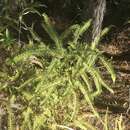Comments
provided by eFloras
Plants in Florida tend to be depauperate when compared to tropical populations; individual leaves are smaller and plants seldom form dense thickets. Dicranopteris flexuosa appears to be a natural element in the flora (J. R. Burkhalter 1985; R. Moyroud and C. E. Nauman 1989). Plants may not persist very long, however, as evidenced by Alabama and some Florida populations that are no longer extant.
- license
- cc-by-nc-sa-3.0
- copyright
- Missouri Botanical Garden, 4344 Shaw Boulevard, St. Louis, MO, 63110 USA
Description
provided by eFloras
Stems 2--5 mm diam.; hairs reddish brown to chestnut brown, falling off early. Leaves to more than 1 m, axes straw-colored, glabrous except at petiole base. Penultimate segments sessile, divergent to ascending, in ± equal pairs, deeply pinnatisect, lanceolate to oblanceolate, to 30 × 6 cm wide, leathery, glabrous, whitish waxy or glaucous abaxially. Ultimate segments linear, slightly dilated proximally, margins strongly revolute, apex retuse. Sori nearer midrib than margin; sporangia usually 6--12 per sorus.
- license
- cc-by-nc-sa-3.0
- copyright
- Missouri Botanical Garden, 4344 Shaw Boulevard, St. Louis, MO, 63110 USA
Distribution
provided by eFloras
Ala., Fla.; Mexico; Central America; South America.
- license
- cc-by-nc-sa-3.0
- copyright
- Missouri Botanical Garden, 4344 Shaw Boulevard, St. Louis, MO, 63110 USA
Habitat
provided by eFloras
Terrestrial and climbing on open slopes in drainage ditches; widespread, tropical; 0m.
- license
- cc-by-nc-sa-3.0
- copyright
- Missouri Botanical Garden, 4344 Shaw Boulevard, St. Louis, MO, 63110 USA
Synonym
provided by eFloras
Mertensia flexuosa Schrader, Gött. Gel. Anz. 1824: 863. 1824; Gleichenia flexuosa (Schrader) Mettenius
- license
- cc-by-nc-sa-3.0
- copyright
- Missouri Botanical Garden, 4344 Shaw Boulevard, St. Louis, MO, 63110 USA
Comprehensive Description
provided by North American Flora
Dicranopteris flexuosa (Schrad,) Underw. Bull. Torrey
Club 34 : 254. 1907.
Mertensia flexuosa Schrad. Goett. Gel. Anz. 1824 : 863. 1824.
Mertensia rigida Kunze, Linnaea 9 : 16. 1834.
Gleichenia fie xuosa Mett. Ann. Lugd. Bat. 1 : 50, 1863.
Gleicheniarigida Bommer & Christ, Bull. Soc. Bot. Belg. 35i : 174. 1896. Not G. rigida J. Smith,
1841.
A diffuse semi-erect plant with rigid branches ; rhizome creeping, 2-5 mm. in diameter,
lightto dark-brownish, slightly muricate from the detachment of very numerous deciduous spreading castaneous articulate hairs ; primary leaf-axis at first rigidly erect, stout, 2^ mm. in diameter, firmly terete, light-brown isli or somewhat stramineous, elongate; primary lateral branches several pairs, opposite, distant, repeatedly pseud odichotomous, a secondary leaf-axis invariably wanting, the internodes unequal, naked; primary internodes usually 6-8 (rarely 18) cm. long, the others successively shorter, the nodes stipulate at the upper side (the stipules narrow and subentire to deltoid and deeply pinnatifid), at the lower side provided with spreading or usually deflexed oblong-linear to lanceolate-oblong pectinate accessory pinnae, the larger ones 8-13 cm. long, up to 2.5 cm. broad, those of the upper nodes gradually smaller ; pinnae sessile, ascending or somewhat divergent, variable, 12-23 cm. long, 2-6 cm. broad, attenuate, fully pectinate (the outer basal segments often prolonged and deeply pinnatifid), straight, subfalcate or slightly flexuous, linear to oblonglanceolate, cut nearly to the rachis, glabrous throughout, lightor yellowish-green, glaucous below ; segments variable in size, linear-oblong to linear, retuse, connected by a narrow wing at the dilatate base, the margins strongly revolute, sometimes meeting at the middle of the segment; veins 2-4-forked, close, elevated above, below deeply impressed ; sori numerous if present, multisporangiate, borne upon the distal and sometimes additionally upon the proximal veinlet of each group.
Type locality : Brazil.
Distribution : General in the Greater Antilles, not common in the lycsser Antilles ; on the continent extending from southern Mexico (rare) to Brazil, mainly at low elevations, rarely ascending to 1500 meters.
- bibliographic citation
- Lucien Marcus Underwood, Ralph Curtiss BenedictWilliam Ralph Maxon. 1909. OPHIOGLOSSALES-FILICALES; OPHIOGLOSSACEAE, MARATTIACEAE, OSMUNDACEAE, CERATOPTERIDACEAE, SCHIZAEACEAE, GLEICHENIACEAE, CYATHEACEAE (pars). North American flora. vol 16(1). New York Botanical Garden, New York, NY

